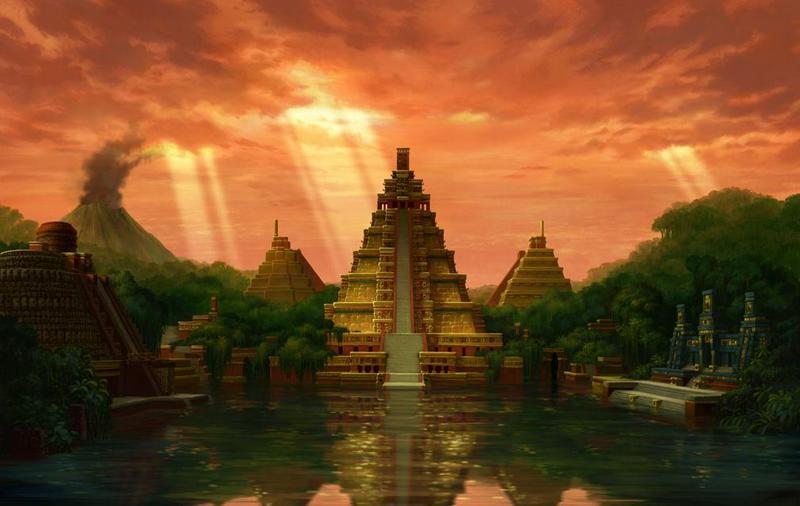El Dorado, The Lost City Of Gold
By | November 10, 2019

From the California Gold Rush to the search for Captain Kidd’s lost treasure, the pursuit of gold, whether mythical or real, has inspired countless expeditions throughout history. The hunt for El Dorado is no exception. Rumors of this legendary lost city of gold go back centuries and were so convincing that it even appeared on maps at one time, despite the fact that the city has never been found.
The term, el dorado, is Spanish for “the golden one” and is connected to the Muisca tribe, also known as the Chibcha tribe, which has existed in Central Columbia since the 9th century. For the Muisca tribe, the golden one was not a city but a man, specifically the tribal chief. During the initiation ceremony, the new chief would be covered in gold dust and taken out on a raft to the center of Lake Guatavita, where he would cast precious jewels and gold into the lake as an offering to the gods. Other descriptions of the ceremony claim that the chief actually submerged himself in the lake to wash off the gold dust.

When the Spanish Explorers arrived in the 16th century, they heard tales of the initiation and begin to refer to the tribal chief as El Dorado. By that time, the practice had ended, but the Europeans had already discovered so much gold among the Incas and the Aztecs that they believed the Chibcha tribe to be concealing a great treasure. In 1545, they even tried to drain Lake Guatavita to get to the treasure and did, in fact, find a significant amount of gold, but they believed it to be only a fraction of the real treasure located at its depths. As a result, El Dorado eventually came to be associated with a hidden city of gold.

Over the next two centuries, many European explorers would travel to the new world in search of El Dorado. The most famous of these was the English courtier, Sir Walter Raleigh, who made two attempts at finding the lost city. The first expedition was in the late 16th century. Raleigh had captured a Spanish explorer named Pedro Sarmiento de Gamboa in 1584. Gamboa told Raleigh about the legendary city, prompting Raleigh to plan a journey which would commence eleven years later. Raleigh made it to Trinidad, where he learned from an explorer named Antonio de Berrio, that El Dorado was located near present-day Venezuela. Unfortunately, Raleigh’s attempt to travel there was impeded by inclement weather and he was forced to turn back.
In 1596, Raleigh sent his lieutenant, Lawrence Keymis, to explore Venezuela in the hopes of learning more about El Dorado. According to Keymis, the city was located near a large lake called Lake Parime. Based on the account of Keymis, Raleigh published two books, The Discoverie of the Large, Rich, and Bewtiful Empyre of Guiana (1596) and The Discovery of Guiana, and the Journal of the Second Voyage Thereto (1606). As a result of these books, Lake Parime and El Dorado began to appear on English maps, with their location falling in the interior of the Guianas.

In 1617, Raleigh made a second trip to South America in search of El Dorado. Due to his advanced age, he was unable to travel further than the island of Trinidad, but the rest of the expedition, including his son, Watt Raleigh, and Lawrence Keymis, continued up the Orinoco River. The expedition invaded a Spanish colony and Watt Raleigh was killed in the ensuing skirmish. Keymis returned to Trinidad to deliver the bad news to Sir Walter Raleigh, killing himself after Raleigh refused to grant him forgiveness. Because the expedition had broken a treaty by clashing with the Spanish, Raleigh himself was executed upon his return to England. Failure to find concrete evidence of the existence of El Dorado and Lake Parime led to them gradually disappearing from maps.

In the 19th century, German explorer Alexander von Humboldt explored South America and explained the perceived existence of Lake Parime as nothing more than river flooding during the wet season. However, in the 1970s, an explorer named Roland Stevenson discovered an extinct lake not far from the Guianas where Lake Parime was once believed to exist. Attempts to locate El Dorado have persisted even into the 21st century. The Monastery of Santo Domingo made an attempt in 2000, with their radar indicating the possible existence of a large tunnel beneath the monastery. In 2001, possible remains of civilization were discovered in the Paratoari area of Peru; however, the terrain of the area makes it difficult to explore. So while El Dorado is unlikely to be reappearing on modern maps, the dream of discovering the city of gold is far from dead.

